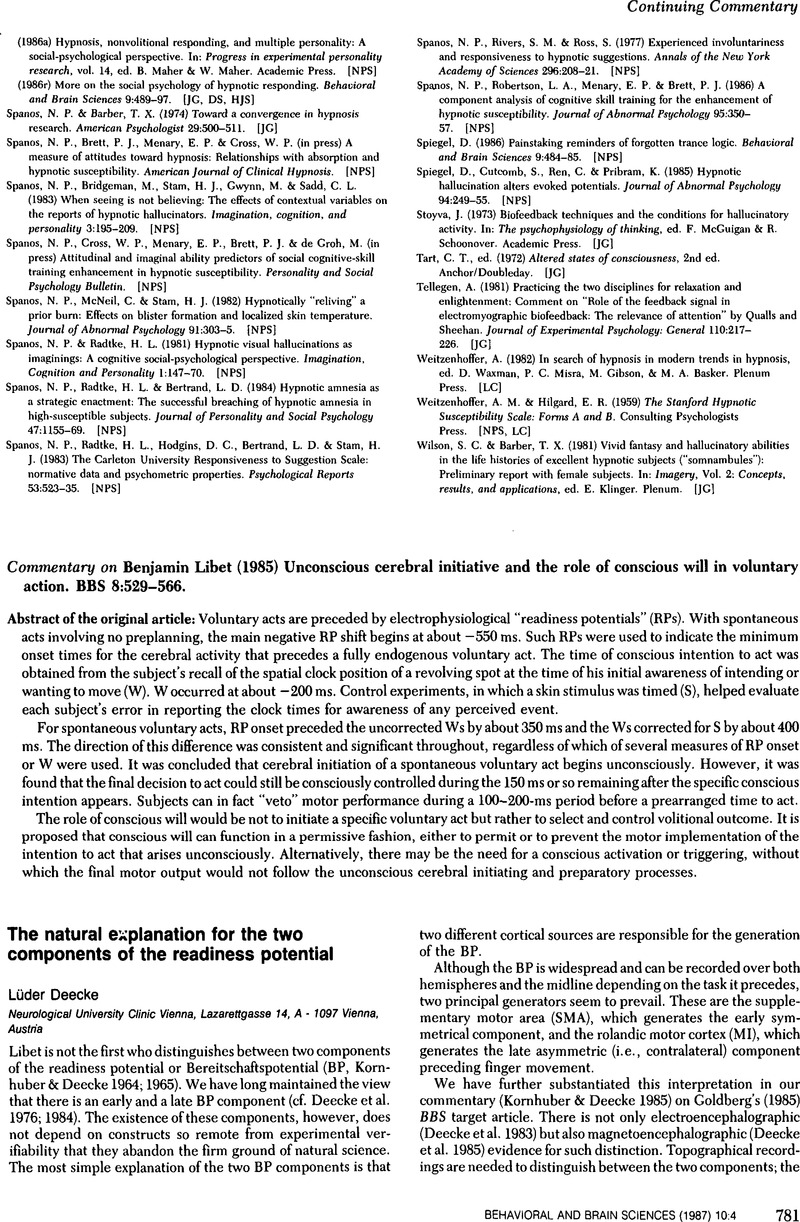No CrossRef data available.
Article contents
The natural explanation for the two components of the readiness potential
Published online by Cambridge University Press: 04 February 2010
Abstract
An abstract is not available for this content so a preview has been provided. Please use the Get access link above for information on how to access this content.

- Type
- Continuing Commentary
- Information
- Copyright
- Copyright © Cambridge University Press 1987
References
Bliss, J. (1980) Sensory experiences of Gilles de la Tourette syndrome. Archives of General Psychiatry 37: 1343–47. [REH, BL]CrossRefGoogle ScholarPubMed
Boschert, J., Hink, R. F. & Deecke, L. (1983) Finger movement versus toe movement-related potentials: Further evidence for supplementary motor area (SMA) participation prior to voluntary action. Experimental Brain Research 55: 73–80. [LD]Google Scholar
Breitmeyer, B. G. (1985) Problems with the psychophysics of intention. Behavioral and Brain Sciences 8: 539–40. [REH, BL]CrossRefGoogle Scholar
Cohen, D. J., Riddle, M. A., Leckman, J. F., Ort, S. & Shaywitz, B. A. (1984) Tourette's syndrome. In: Neuropsychiatric movement disorders, ed. Jeste, D. V. & Wyatt, R. J.. American Psychiatric Press. [REH, BL]Google Scholar
Deecke, L., Bashore, T., Brunia, C, Grünewald-Zuberbier, E., Grunewald, G. & Kristeva, R. (1984) Movement associated potentials and motor control. In: Brain and information: Event-related potentials, ed. Karrer, R., Cohen, J. & Tueting, P.. Annals of the New York Academy of Sciences 425: 398–428. [LD]CrossRefGoogle Scholar
Deecke, L., Boschert, J., Brickett, P. & Weinberg, H. (1985) Magnetoencephalographic evidence for possible supplementary motor area participation in human voluntary movement. In: Biomagnetism: Applications and theory, ed. Weinberg, H., Stroink, G. & Katila, T.. Pergamon. [LD]Google Scholar
Deecke, L., Grozinger, B. & Kornhuber, H. H. (1976) Voluntary finger movement in man: Cerebral potentials and theory. Biological Cybernetics 23: 99–119. [LD, BL]CrossRefGoogle ScholarPubMed
Finke, R. (1979) The functional equivalence of mental images and errors in movement. Cognitive Psychology 11: 235–64. [REH, BL]CrossRefGoogle Scholar
Goldberg, G., Kwan, H. C, Borrett, D. & Murphy, J. T. (1984) Differential topography of the movement-associated scalp potential with internal vs. external dependence of movement timing. Archives of Physical Medicine and Rehabilitation 65: 630. [LD, BL]Google Scholar
Gordon, R. M. (1986) The passivity of emotions. Philosophical Review 95: 371–92. [REH]CrossRefGoogle Scholar
Greenwald, A. (1970a) A double stimulation test of ideomotor theory with implications for selective attention. Journal of Experimental Psychology 84: 392–98. [REH]CrossRefGoogle Scholar
Greenwald, A. (1970b) A choice reaction time test of ideomotor theory. Journal of Experimental Psychology 86: 20–25. [REH]CrossRefGoogle ScholarPubMed
Harnad, S. (1982) Consciousness: An afterthought. Cognition and Brain Theory 5: 29–47. [REH, BL]Google Scholar
Hoffman, R. E. (1986) Verbal hallucinations and language production processes in schizophrenia. Behavioral and Brain Sciences 9: 503–48. [REH]CrossRefGoogle Scholar
Jung, R. (1985) Voluntary intention and conscious selection in complex learned action. Behavioral and Brain Sciences 8: 544–45. [BL]CrossRefGoogle Scholar
Kelso, J. A. (1982) Concepts and issues in human motor behavior: Coming to grips with the jargon. In: Human motor behavior, ed. Kelso, J. A.. Erlbaum. [REH, BL]Google Scholar
Kornhuber, H. H. & Deecke, L.: (1964) Hirnpotentiälanderungen beim Menschen vor und nach Willkürbewegungen, dargestellt mit Magnetbandspeicherung und Rückwärtsanalyse. Pfügers Arch. 281: 52. [LD, BL]Google Scholar
Kornhuber, H. H. & Deecke, L. (1965) Hirnpotentialanderungen bei Willkurbewegungen und passiven Bewegungen des Menschen: Bereitschaftspotential und reafferente Potentiale. Pflügers Archiv für Cesamte Physiologie 284: 1–17. [LD, BL]CrossRefGoogle Scholar
Libet, B. (1985) Unconscious cerebral intiative and the role of conscious will in voluntary action. Behavioral and Brain Sciences 8: 529–39, 529–66.CrossRefGoogle Scholar
Libet, B. (1985r) Theory and evidence relating cerebral processes to conscious will. Behavioral and Brain Sciences 8: 558–66. [REH, BL]CrossRefGoogle Scholar
Libet, B., Gleason, C. A., Wright, E. W. & Pearl, D. K. (1983) Time of conscious intention to act in relation to onset of cerebral activities (readiness-potential); the unconscious initiation of a freely voluntary act. Brain 106: 623–42. [BL]CrossRefGoogle ScholarPubMed
Libet, B., Wright, E. W. Jr & Gleason, C. A. (1982) Readiness-potentials preceding unrestricted “spontaneous” vs. preplanned voluntary acts. Electroencephalography and Clinical Neurophysiology 54: 322–35. [BL]CrossRefGoogle ScholarPubMed
MacKay, D. M. (1985) Do we “control” our brains? Behavioral and Brain Sciences 8: 546. [BL]CrossRefGoogle Scholar
Obeso, J. A., Rothwell, J. C. & Marsden, C. D. (1981) Simple tics in Gilles de la Tourette's syndrome are not prefaced by a normal premovement EEG potential. Journal of Neurology, Neurosurgery, and Psychiatry 44: 735–38. [REH, BL]CrossRefGoogle Scholar
Scheerer, E. (1985) Conscious intention is a mental fiat. Behavioral and Brain Sciences 8: 552–53. [REH, BL]CrossRefGoogle Scholar
Shibasaki, H., Barrett, G., Halliday, E. & Halliday, A.M. (1980) Components of the movement-related cortical potential and their scalp topography. Electroencephalography and Clinical Neurophysiology 49: 213–26. [BL]CrossRefGoogle ScholarPubMed
Sperry, R. W. (1976) Changing concepts of consciousness and free will. Perspectives in Biology and Medicine 20: 9–19. [BL]CrossRefGoogle ScholarPubMed
Sperry, R. W. (1980) Mind-brain interaction: Mentalism, yes; dualism, no. Neuroscience 5: 195–206. [BL]CrossRefGoogle Scholar
Wittgenstein, L. (1980) Remarks on the philosophy of psychology, ed. Wright, G. H. von & Nyman, H.. University of Chicago Press. [REH]Google Scholar
Wood, C. C. (1985) Pardon, your dualism is showing. Behavioral and Brain Sciences 8: 557–58. [REH]CrossRefGoogle Scholar
Zivin, G. (1986) Image or neural coding of inner speech and agency? Behavioral and Brain Sciences 9: 534–35. [REH]CrossRefGoogle Scholar


